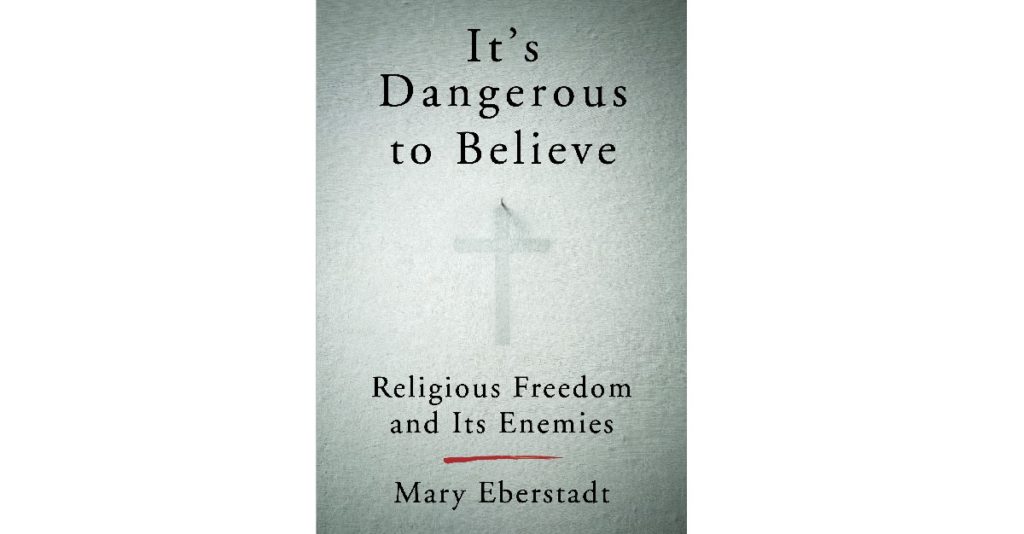Editor’s Note: Mary Eberstadt will be speaking about It’s Dangerous to Believe on Tuesday, June 28th at 12:00 PM. Listen online here.
During my first few weeks in America, I vividly remember my mom gasping in surprise and pointing out a large cross on a hill overlooking the freeway in southern California. As my dad tried to concentrate on driving, my mother exclaimed with amazement (in Arabic): “They allow crosses on hills in America!” My father brought me to America so that I could have freedom of religion, freedom of expression, and freedom of thought. We never thought that they would be curtailed. We never thought that a day would come when people would agitate over crosses on hills, the Decalogue in courthouses, and pro-life pins on lapels. My father brought me here. If this trajectory continues, where might I take my children?
This is the precise question with which Mary Eberstadt begins the introduction to her small but mighty book, It’s Dangerous to Believe: Religious Freedom and Its Enemies. Faced with hardships, vilifications, and discriminations great and small, many believers have begun to ask: “Where will we go?” Inspired by their experiences, Eberstadt offers an extended meditation on secular progressivism’s “soft persecution” of Christians and religious freedom.
But we can’t comprehend our current cultural clashes without understanding the history that gave rise to the new intolerance of today. Knowing this, Eberstadt walks us briefly from the philosophical skepticism of Voltaire to twentieth-century anti-religious campaigns. A little more than a decade ago, assaults on religious liberty and on Christian men and women began to accelerate and escalate. Eberstadt points to two seismic cultural events that contributed to this escalation: first, the terrorist attacks of September 11; and second, the Catholic Church’s catastrophic sex abuse scandals. Together, these two events gave not only the “new atheism” movement but all unbelievers the impetus to start clearing away the vestiges of American religion. Eberstadt recounts the evidence of discrimination, financial bullying, legal warfare, harassment, social media shaming, and many other forms of intimidation used by secular progressive activists to shut down Christians.
Start your day with Public Discourse
Sign up and get our daily essays sent straight to your inbox.Eberstadt is a superb analyst. Her hypothesis—carefully demonstrated and ringing true—is that secular progressivism is not just a political ideology; it is a competing faith, a religion. It is a secular faith that emerged out of the sexual revolution. This faith is Kantian in nature, following the categorical imperative as an ethical guide. The messianic political religion that is secular progressivism has its own theology, creed, morality, saints, demons, missionaries, proselytizers, and sacraments. It has its own alternative orthodoxy, which mimics Christianity. Its messiah is a liberated sexuality, and its first principles are the “primacy of pleasure and self-will.”
Eberstadt’s framing of the movement in this way does not represent some hyperbolic or imagined Christian martyr complex. The notion that secular progressivism operates as a faith may not be novel, but it is a valuable paradigm, worth exploring deeply. She leads the way in this exploration, calling for a change in our engagement. The strategies she lays out will involve convincing open-minded secularists that it is in everyone’s interest to return to the basics of a free society—a society in which we allow others to hold different beliefs without ostracizing them. But first we need to pull back from the current collective hysteria, scare tactics, and witch hunts.
Modern Witch Hunts
Eberstadt shows the similarities between the Salem witch trials, the environment surrounding the forged Protocols of the Elders of Zion, Nazi anti-Semitism, the Red Scare, McCarthyism, and—most recently—the collective panic in the 1980s over day-cares abusing children. As she skillfully demonstrates, the same mechanism is being used by today’s secular progressives against Christians: isolation, stigmatization, and social and economic punishments. The epithets themselves have morphed: “‘bigot’ and ‘hater’ are the new ‘wizard’ and ‘witch,’” she notes. These “Salem-esque” hunts are conducted with “inquisitorial zeal” and flimsy evidence. In the new dispensation of the sexual revolution, Eberstadt writes, “yesterday’s ‘sinners’ have become the new secular saints; and yesterday’s ‘sins’ have become virtues, as positive expressions of freedom.” Anyone still holding to traditional sexual mores will pay the price. In effect, Christians in America have become second-class citizens: dhimmis.
Where does one begin enumerating this new aggression against traditional Christians? Eberstadt examines story after story. Because of its fealty to biblical moral teachings, InterVarsity Christian Fellowship was kicked out of all twenty-three California State University campuses; it has been purged from other colleges around the country and continues to be challenged. After forty years of being on campus at California State Stanislaus, the Christian group Chi Alpha was stripped of official recognition. The student chapter of the Christian Legal Society at Hastings College of Law was denied campus status. There have been attacks on Christian homeschoolers, Catholic adoption agencies, and Christian colleges. A Christian day-care staff member was fired for not addressing a six-year-old girl as a transgender boy, and an adjunct professor was suspended for teaching natural law as part of a modern Catholic social thought class.
Eberstadt also writes about Ryan Anderson, the editor of this journal, who has had to bear more than his share of shaming and harassment. “His public appearances are now lightning rods for ideological malevolence of a kind without counterpart elsewhere on the spectrum,” Eberstadt writes. This exchange between Anderson and a New York Times reporter moved me to tears:
[While] Anderson repeatedly made the case for civility and respect for opposing perspectives, the reporter responded with “Why shouldn’t I call you names?” and “Civility is not always a virtue” and “Some people are deserving of incivility” and “obviously some policy views render people unworthy of respect.” Anderson explained, “people are always worthy of respect, even if their policy views are misguided. Nothing renders people ‘unworthy of respect.’” He continued: “I think even when we vehemently disagree with someone the person still has innate human dignity, still worthy of respect.”
The common denominator beneath all these witch hunts “is the protection of the perceived prerogatives of the sexual revolution at all costs,” writes Eberstadt. In essence, believers are seen as a threat to laissez-faire sexual morality. What is going on under the surface of these clashes? What is it driving these people to shut down even charities, whose sole business is feeding the hungry, sheltering the orphan, and helping the poor? Eberstadt sees “deep creedal passions.” She writes:
they do not think what they do is deplorable. They believe they are in possession of a higher truth, and they fight to universalize it—to proselytize just as anyone else who believes himself charged with guardianship of the Truth seeks to do.
The so-called culture wars are not about libertarian freedom versus religious unfreedom. They’re about a conflict between two rival faiths. [Emphasis added]
One of the most disheartening results of these witch hunts is their destruction of charitable works. Intimidating and litigating charities out of existence has a steep price, and those who pay it are the poor and needy. Christianity has a two-thousand-year history of ministering to those in need. If religious institutions and infrastructure that have been built over the years are shut down, they will not be easily replaced by secular organizations. As Eberstadt puts it: “the organically grown, intricate, transnational networks built by Christians and their charities in the course of years, decades, and even centuries are not replaceable—not overnight, not a hundred years from now, and certainly not by governmental bureaucracies.”
What Can Christians Do?
In spite of all of these disheartening social trends, Eberstadt does a commanding job justifying a strategy of active, hopeful, patient engagement. This is where Eberstadt’s wisdom really shines.
Believers of every stripe need to come to terms with what is going on. We must gain clarity about secular creeds and their competing first principles. We need to understand that this competition may be unavoidable, but its result is far from inevitable. This attempted redefinition of humanity is not some Hegelian process that takes us one way through history to a new tomorrow. There are two possible choices for adherents of the new faith born out of the sexual revolution. They can either follow their Puritan forebears by punishing all who are “heretics,” or, Eberstadt writes, “they can opt for what Thomas Jefferson and other Founders developed as an antidote to Puritan destructiveness, namely, the shared understanding that one’s own liberty isn’t safe until everyone else’s is protected.”
Just like other religions, the secular progressive faith must unite faith with reason. This is what will pull them back from sabotaging the entire American project. And although Eberstadt doesn’t necessary put it in those terms, that is what she is calling for by making an appeal to open-minded secularists of good will—those who value genuine diversity in the realm of ideas—to remember what true liberalism entails. An intra-secular conversation leading to a more temperate secular faith should be encouraged. There is now in the secular progressive camp a feverish adherence to its orthodoxy without the balance of reason. Only secular progressives themselves can rein in their own unruly activists, their extremists.
Eberstadt offers a key insight into the events that finally ended the terror of the Salem witch trials, the Red Scare, and McCathyism: people on the persecutors’ side acknowledged that things had gone too far. Someone must echo the words of army counsel Joseph Welch to Joseph McCarthy: “You’ve done enough. Have you no sense of decency, sir, at long last? Have you left no sense of decency?” If today’s believers and unbelievers are to live together as the Founding Fathers had envisioned, if we want to regain and keep our free society as it was intended, then “about matters concerning the sexual revolution,” Eberstadt writes, “as about other articles of deeply held faith, people must agree to disagree. That is the sine qua non of a more civil tomorrow.”
The vindictiveness of secular progressives is real, and there’s a lot of it. Eberstadt’s examples leave one with the impression that secularists are barely holding back from muttering “now it’s your turn to be suppressed and subjugated.” Only Christian love can absorb that kind of hatred. We are capable of spiritual, moral, and political renewal. We have the spiritual and intellectual patrimony to bring true tolerance and civility back to America. The Christian moral code has endured minority status before and overcome—it evangelized from the catacombs. It will be the beauty of living out the truth of Christianity, not just asserting them, that will change hearts.
The sexual revolution has given rise to “counterrevolutionaries—people who are persuaded toward religion itself, and act upon their convictions.” Men and women, battered by years spent believing and living the empty lies of the sexual revolution, are being awakened. “Christianity,” Eberstadt observes “is being built more and more by these witnesses—by people who have come to embrace the difficult, long-standing rulebook not because they know nothing of the revolution and its fallout, but because they know too much.” Watching this spiritual renaissance around us should give us hope.













